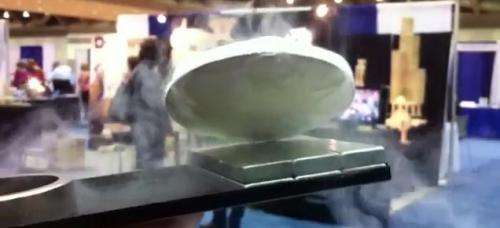October 19, 2011 weblog
Quantum levitating (locking) video goes viral

(PhysOrg.com) -- A video created by researchers at Tel Aviv University in Israel has the Internet buzzing. Though rather simple, it just looks really cool, hence all the attention. It’s a demonstration of quantum locking, though to non-science buffs, it looks more like science fiction come to life. In the video a disc, obviously frozen due to the vapor rising from its surface hovers over a surface.
This is nothing new of course, everyone’s seen it in science class. What is new is that when the demonstrator turns the disc, it stays hovered at that angle. This is in contrast to the wobbling we’re used to in such demonstrations. Next, the disc is set over a different surface where it is made to spin. But that’s only the beginning. The disc is then set on a track where it zips around in midair. And again, it can be made to do so at whatever angle is desired. Then, the track is turned upside down and the disc hovers below it, again zipping around.
Most of the web sites out there seem stumped as to how these guys pulled off this little trick. Fortunately, the researchers explain it in detail. And even more fortunately, it’s not that hard to understand.
First a thin sapphire wafer is created. It is then coated with a very thin ceramic layer of yttrium barium copper oxide which becomes a superconductor (materials that conduct electricity with no loss of energy) at very cold temperatures. The result is a frozen disc. When it is placed over a magnet, the superconductor material and magnet repel one another due to the Meissner effect (the expulsion of the magnetic field from a material when it goes into a superconducting state). But, because the layer of superconducting material is so thin, some of the magnetic force is allowed through at certain particularly weak points. These paths through are called flux tubes, and they are the real secret to the whole trick. Because there are many of them they cause a three dimensional holding or locking effect, which is what viewers see when watching the video.
Upon viewing the video, a lot of commentators refer to the scene in Back to the Future 2 when Mary McFly rides a hoverboard for a few minutes. Unfortunately, the science demonstrated in this latest video holds no hope for that; not unless someone figures out how to keep such boards frozen indefinitely (and embeds magnets everywhere) or better yet, figures out a way to make a superconductor that works at room temperature.
© 2011 PhysOrg.com

















